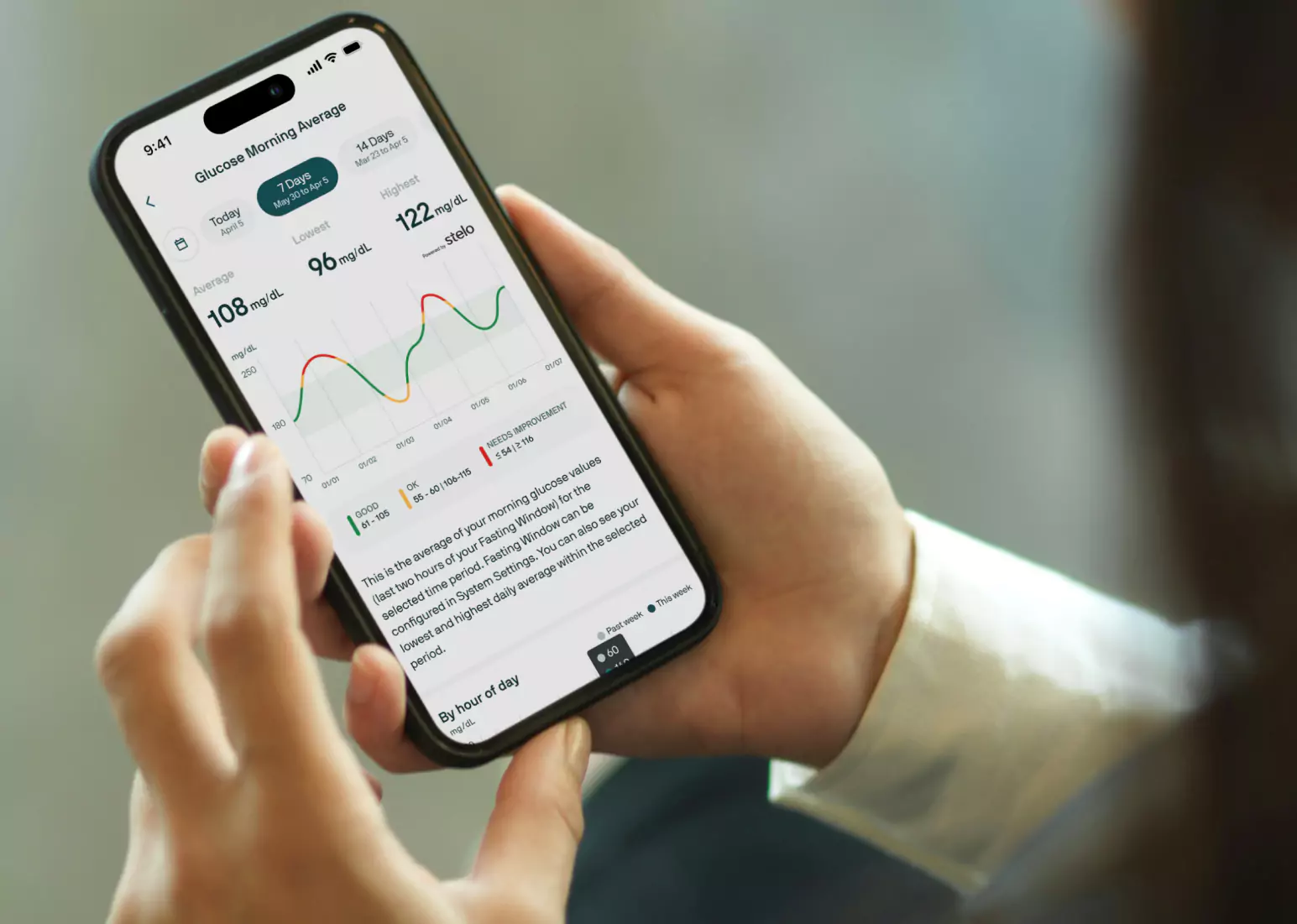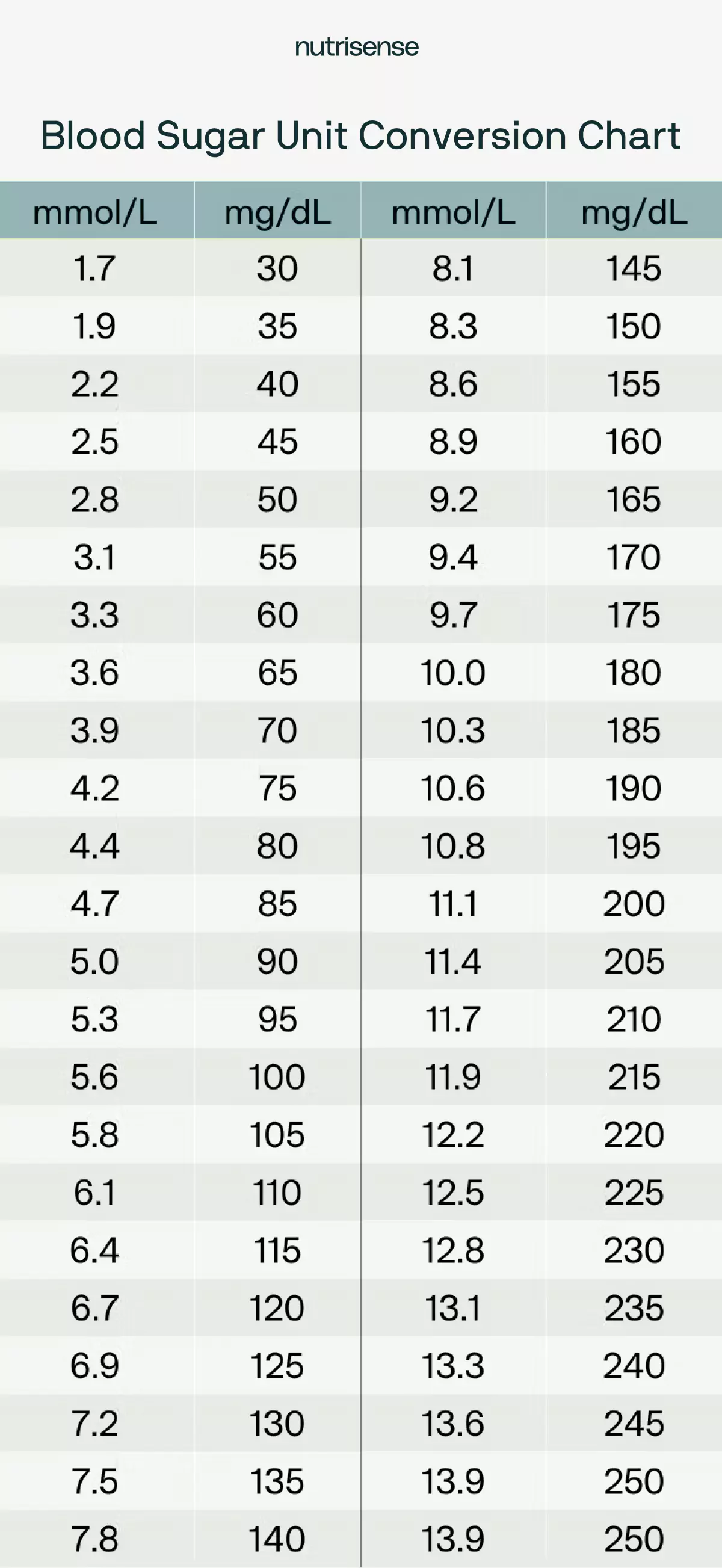How to Read a Blood Sugar Conversion Chart

Key Takeways
Keeping your blood sugar levels in an optimal range is an important factor in managing your metabolic health. Blood sugar levels can be measured using tools like a continuous glucose monitor (CGM) or a blood glucose meter (BGM). These devices provide you with a glucose value that can help you understand your body’s response to your dietary and lifestyle choices.
If you’ve just started using either a glucose biosensor, CGM or a BGM to monitor your glucose levels (these devices measure interstitial glucose), understanding the way blood sugar levels are measured can help you easily interpret your results and make it easier to focus on reaching your health goals. Read on to discover the differences between each blood sugar measurement, plus how to read a blood sugar conversion chart.
What is a Blood Sugar Conversion Chart?
A blood sugar conversion chart, as the name implies, is a two column chart that displays the conversion of blood glucose levels from one unit to another. On one side, you’ll see a list of blood glucose levels measured in milligrams per deciliter (or mg/dL), which is commonly used in the USA. On the other side, you’ll see blood glucose levels in millimoles per liter (or mmol/L), which is used in medical journals and countries such as the U.K.
A conversion chart is set up so that the different blood glucose values for each unit are listed next to their converted value, making it easy to quickly convert and interpret your measurement. Some charts may also include an additional column for A1C levels, which is used to measure your average glucose levels over a longer period of time.
How to Read a Blood Sugar Conversion Chart

Fortunately, interpreting a blood sugar conversion chart is usually quite straightforward. Understanding what your blood glucose levels mean for your health, however, is what may require a little more investigation. But don’t worry, we’ll get into that later on!
If you’ve already measured your glucose levels using a device such as a CGM or glucose biosensor, you’ll already have a value calculated in either mg/dL or mmol/L. If you need to convert your reading from one measurement to another, you can simply reference your blood sugar conversion chart. You’ll then be able to match your value to the equivalent number in the other unit.
{{rich-text-cta-2="/style-guide"}}
3 Important Readings to Consider On A Blood Sugar Conversion Chart
It’s important to understand how different blood glucose values may impact your health, since high or low blood sugar levels can have serious implications for your metabolic health and overall wellbeing.
While normal blood glucose values may vary slightly for each person, there are a few ranges you should be aware of that can help you determine if your blood sugar is optimal.
Fasting Blood Glucose Levels: 70-99 mg/dL

Blood glucose levels between 70 to 99 mg/dL, or 3.9 to 5.5 mmol/L, are considered to be normal for adults without diabetes. Some researchers have argued for a a smaller range of 70 to 90 mg/dL, to potentially lower the risk of developing prediabetes or type 2 diabetes.
Although these levels are considered optimal, fluctuation is normal and certain individuals may thrive at different blood glucose values within this range. Remember that many factors can affect your blood sugar, and there are also ways to improve your blood sugar levels over time.
However, before making significant dietary or lifestyle changes, consult with a healthcare professional or registered dietitian to discuss your individual health needs.
Fasting Blood Glucose Levels: 100-125 mg/dL
Fasting blood glucose levels between 100 to 125 mg/dL, or 5.6 to 6.9 mmol/L, are considered elevated and are classified as outside of the normal range. This range may indicate or lead to the onset of prediabetes. A prediabetes diagnosis can put you at a greater risk of developing type 2 diabetes, high blood pressure, blood lipid disorders, and other adverse conditions.
People with elevated fasting glucose levels may want to have a conversation with a healthcare professional or a qualified dietitian or nutritionist about making lifestyle changes to stabilize their levels.
Fasting Blood Glucose Levels: 126 mg/dL or Higher

Fasting blood glucose levels of 126 mg/dL (or 7.0 mmol/L) or higher are found in individuals with type 2 diabetes. Chronically high blood sugar levels can indicate that your body has a dysfunction with regulating glucose in the bloodstream.
A high fasting glucose reading can be a result of insulin resistance, genetics, low exercise levels, or a mix of several factors. Things like getting more exercise and finding the right eating plan for your health (such as a low-carb keto diet) are just a few things that may help improve your levels.
However, to determine the causes and treatment options for your individual needs, consult a healthcare professional.
{{rich-text-cta-member-stories="/style-guide"}}
Understanding the Difference Between Mmol/L and Mg/dL
Both mg/dL and mmol/L are used to measure blood glucose levels in slightly different ways. However, the main distinction is simply in which area of the world each measurement is used.
The measurement of mmol/L measures the concentration of blood glucose, or the number of molecules, in one liter of blood. In contrast, the measurement mg/dL measures the concentration, or the ratio of the weight of blood glucose to liters.
Important Formulas to Keep in Mind

Knowing the difference between these two different measurements and how to calculate them can be important as you deepen your understanding of blood sugar levels and their effect on the body.
If you don’t have access to a blood sugar conversion chart, here are two simple formulas to help you switch between these two different measurement units with ease.
Formula to Calculate Mmol/L From Mg/dL
1 mmol/L of blood glucose is equivalent to 18 mg/dL of blood glucose. So, if you're trying to calculate mmol/L from mg/dL, you can multiply the mg/dL value by 0.0555 to get the equivalent mmol/L value of blood glucose.
Here’s an Example Calculation:
105 mg/dL x 0.0555 = 5.83 mmol/LIf you recall the blood glucose ranges we discussed, this value would fall into the prediabetic range.
Formula to Calculate Mg/dL from Mmol/L

On the other hand, if you’re trying to convert from mmol/L to mg/dL, simply multiply the mmol/L number by 18.
Here’s a Sample Calculation:
4 mmol/L x 18 = 72 mg/dL blood glucose.
This value, as we discussed earlier, would fall within the normal adult range.
Find the right Nutrisense programto turn insight into progress.
Get More from Your Glucose with Nutrisense
Understanding your blood sugar levels is crucial to help maintain your overall wellbeing. Monitoring glucose is one way to keep an eye on it. This is where signing up for a program like Nutrisense can make all the difference, especially with the 1:1 access to a team of glucose experts through 1:1 insurance-covered video calls with a registered dietitian or nutritionist. The team of glucose-certified experts is trained to work with your body’s data; you can see what is affecting your glucose levels and find actionable ways to balance them based on your unique needs.
With Nutrisense, you also get access to glucose biosensors that measure interstitial glucose, or you can connect any compatible continuous glucose monitor (CGM) to the Nutrisense App and unlock powerful insights into your glucose levels. To read your glucose conversion charts, you can work with Nutrisense's credentialed experts, who are all glucose-experts and have various specialties, from weight loss and prediabetes to sports nutrition, women's health, and more. They provide personalized support to help you interpret your data and make informed lifestyle choices, so you have the tools and guidance you need to optimize your health.
Ready to get started? Take our quiz to see how Nutrisense can help you achieve your health goals.
Go Beyond Glucose Data with Nutrisense
Your glucose can significantly impact how your body feels and functions. That’s why stable levels are an important factor in supporting overall wellbeing. But viewing glucose isn't enough. Nutrisense, you’ll be able to learn how to use your body's data to make informed lifestyle choices that support healthy living.
One-to-one coaching
Sign up to access insurance-covered video calls to work with a glucose expert: a personal registered dietitian or certified nutritionist who will help tailor your lifestyle and diet to your goals.
Monitor and measure what matters
With the Nutrisense CGM Program, you can monitor your glucose with health tech like glucose biosensors and continuous glucose monitor (CGM)s, and analyze the trends over time with the Nutrisense App. This will help you make the most informed choices about the foods you consume and their impact on your health.
Find your best fit
Ready to take the first step? Start with our quiz to find the right Nutrisense program to help you take control.

Heather is a Registered and Licensed Dietitian Nutritionist (RDN, LDN), subject matter expert, and technical writer, with a master's degree in nutrition science from Bastyr University. She has a specialty in neuroendocrinology and has been working in the field of nutrition—including nutrition research, education, medical writing, and clinical integrative and functional nutrition—for over 15 years.




